How to Maintain Optimal Cage Hygiene for Chinchillas

Chinchillas are small, active rodents that require a clean and hygienic living environment to stay healthy. Proper cage hygiene is crucial in preventing diseases and ensuring the well-being of these pets. Regular cleaning and maintenance routines are essential to keep the chinchilla’s enclosure in optimal condition.
This includes daily spot cleaning to remove soiled bedding, uneaten food, and droppings. Weekly deep cleaning should involve removing all bedding, scrubbing the cage with pet-safe disinfectant, and thoroughly drying it before adding fresh bedding. Additionally, providing a dust bath for chinchillas to roll in helps them maintain their fur cleanliness and overall hygiene. By following these key practices, chinchilla owners can create a healthy and safe environment for their pets.
Proper ventilation is also important in maintaining cage hygiene. Adequate airflow helps prevent the buildup of ammonia from chinchilla urine, which can be harmful to their respiratory system. Placing the cage in a well-ventilated area and using a cage with proper ventilation openings can help ensure good air circulation. Regularly checking and cleaning air vents or filters is necessary to prevent dust and debris from accumulating and affecting air quality within the cage.
Owners should also be mindful of the temperature and humidity levels in the chinchilla’s environment, as excessively high or low levels can impact their health and comfort. Providing a comfortable and clean living space is essential for the overall well-being of chinchillas.
Cage Location and Placement
When considering cage location and placement for chinchillas, it’s crucial to select an area that provides adequate ventilation and natural light. Proper cage ventilation is essential to ensure fresh air circulates within the enclosure, preventing the buildup of harmful odors and ensuring your chinchilla’s respiratory health. Additionally, exposure to natural light is beneficial for your chinchilla’s well-being, helping to regulate their internal clock and providing necessary cues for their natural behaviors.
In terms of cage security and escape prevention, it’s vital to place the chinchilla’s cage in a safe and secure location. Ensure that the cage is placed away from potential hazards such as other pets, electrical cords, or household chemicals. Check the cage regularly for any loose parts or areas where your chinchilla could potentially escape, as these small creatures are adept at finding even the tiniest openings. By prioritizing cage security and escape prevention, you can provide a safe and comfortable environment for your chinchilla to thrive.
Suitable Cage Size and Layout
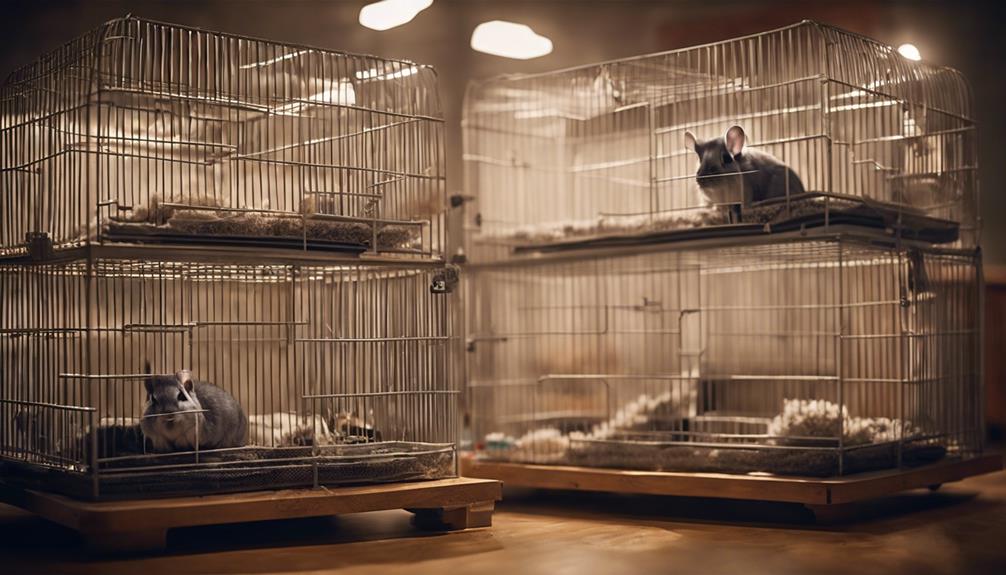
To ensure the well-being and comfort of your chinchilla, determining the appropriate cage size and layout is crucial. Chinchillas are active and energetic animals that require ample space to move around and engage in natural behaviors. When selecting a cage, opt for one that’s at least 16 inches by 18 inches in floor space per chinchilla, with multiple levels or platforms for climbing. Including climbing accessories such as wooden ledges or ramps can help satisfy their natural instincts and provide enrichment. Additionally, incorporating hideout shelters within the cage gives chinchillas a sense of security and privacy, which is essential for their well-being.
Creating a layout that allows for the inclusion of these elements while still leaving enough room for your chinchilla to exercise and play is key. Remember to provide playtime outside of the cage in a chinchilla-proofed area to allow for extra exercise and mental stimulation. By carefully considering cage size and layout, you can create a comfortable and enriching environment for your chinchilla’s overall health and happiness.
Proper Bedding Selection
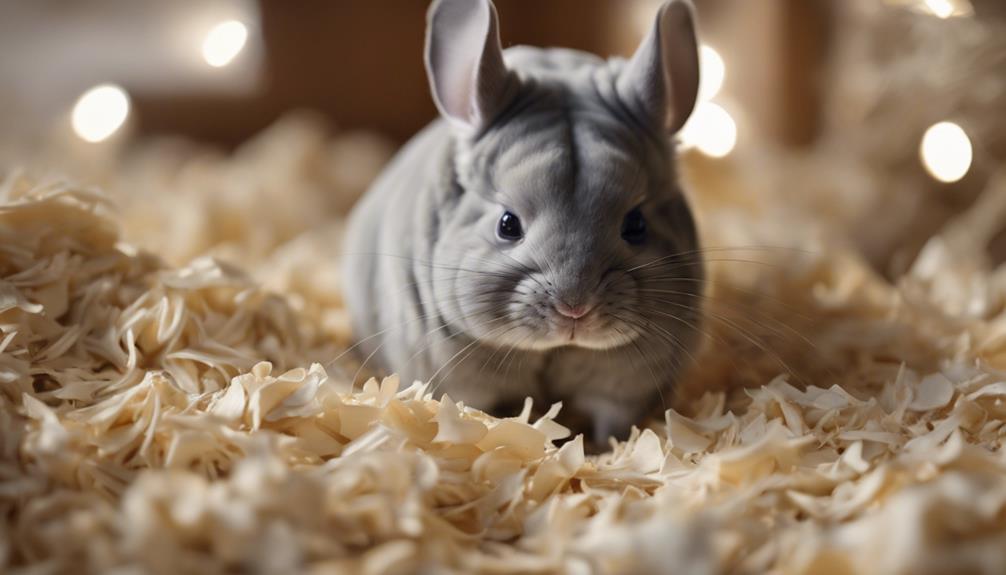
When selecting bedding for chinchillas, it’s crucial to consider the material type, absorbency, and odor control properties.
The right bedding material can help maintain a clean and comfortable environment for your chinchilla.
Understanding these key factors will contribute to the overall hygiene and well-being of your pet.
Bedding Material Types
Selecting the appropriate bedding material is crucial for maintaining cage hygiene for chinchillas. When considering bedding options, preferences can vary based on factors such as absorbency, odor control, and chinchilla sensitivity.
Wood shavings, such as aspen or kiln-dried pine, are popular choices due to their absorbency and affordability. However, some chinchillas may be sensitive to the aromatic oils in pine shavings.
Paper-based beddings, like recycled paper or pulp, are dust-free and gentle on chinchilla’s feet, but they may not control odor as effectively.
Fleece liners offer a reusable and soft bedding option, reducing dust and providing comfort, but they require more frequent cleaning.
Each bedding type has its pros and cons, so it’s essential to consider your chinchilla’s needs and preferences when making a selection.
Absorbency and Odor Control
Choosing a highly absorbent bedding material is essential for effective odor control and maintaining cage hygiene for chinchillas. To ensure optimal absorbency and odor control, consider the following tips:
- Select Appropriate Bedding: Choose bedding materials like aspen shavings, paper-based bedding, or fleece liners known for their absorbent properties.
- Regular Spot Cleaning: Remove soiled bedding daily to prevent odors from building up.
- Proper Ventilation: Ensure good cage ventilation to reduce moisture levels and control odors.
- Deep Clean Weekly: Completely change and clean the cage weekly to maintain hygiene.
- Avoid Dusty Bedding: Opt for dust-free bedding to prevent respiratory issues in chinchillas.
Regular Spot Cleaning Routine
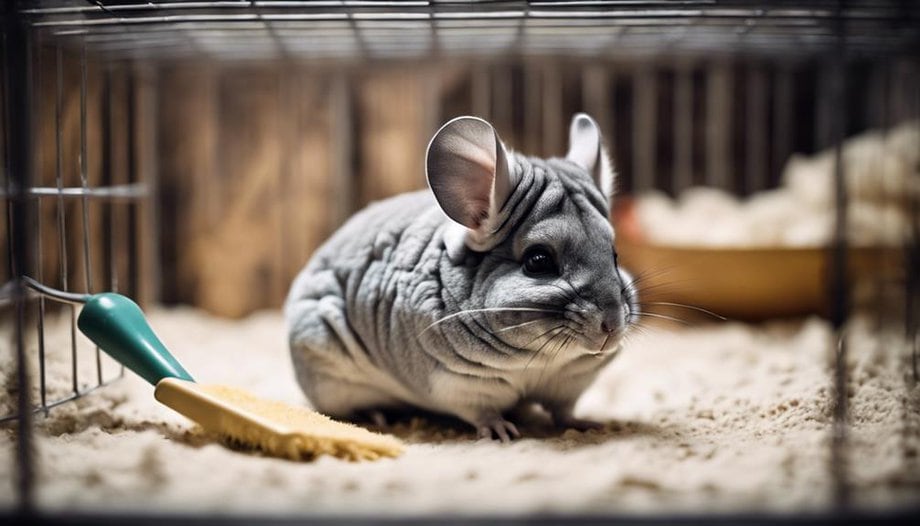
Chinchilla owners should establish a regular spot cleaning routine to maintain a clean habitat for their pets.
Using safe cleaning products is essential to prevent any harm to the chinchillas.
Regularly removing soiled bedding can help prevent odors and keep the cage fresh.
Use Safe Cleaning Products
Consider using gentle, non-toxic cleaning products for maintaining the hygiene of your chinchilla’s cage during your regular spot cleaning routine. When selecting cleaning products, opt for safe disinfectants and natural alternatives to ensure the well-being of your pet. Non-toxic cleaners, such as a vinegar solution, can effectively clean the cage without posing any harm to your chinchilla.
Here are some key points to remember when choosing safe cleaning products:
- Prioritize products labeled as pet-safe or non-toxic.
- Avoid harsh chemicals like bleach or ammonia.
- Opt for natural ingredients like baking soda or lemon for a gentle clean.
- Dilute cleaning solutions appropriately to prevent any strong odors.
- Test new products on a small area before applying them to the entire cage.
Remove Soiled Bedding
When maintaining cage hygiene for chinchillas, regularly removing soiled bedding is essential to ensure a clean and healthy environment for your pet. Bedding disposal techniques are crucial to prevent odor build-up and bacterial growth. It is recommended to spot clean the cage daily and perform a full bedding change once a week. Here is a table detailing effective bedding disposal techniques and hygiene products for chinchillas:
| Bedding Disposal Techniques | Hygiene Products for Chinchillas | Frequency |
|---|---|---|
| Remove soiled bedding promptly | Chinchilla-safe disinfectant | Daily |
| Dispose of bedding in sealed bags | Chinchilla-friendly cage deodorizer | Weekly |
| Wash and sanitize cage accessories | Dust bath powder | Monthly |
Deep Cleaning Schedule
Developing a regular deep cleaning schedule is crucial for maintaining optimal cage hygiene for chinchillas. This ensures a clean and healthy environment for these small pets. Here are some key points to consider when establishing a deep cleaning routine:
- Cleaning Frequency: Determine how often deep cleaning is needed based on the number of chinchillas in the cage and their habits.
- Equipment: Invest in high-quality cleaning tools such as a vacuum, brushes, non-toxic cleaners, and gloves for safety.
- Sanitization Methods: Use appropriate sanitization methods like hot water and vinegar solutions to eliminate bacteria and odors effectively.
- Benefits: Regular deep cleaning helps prevent the buildup of harmful bacteria, reduces the risk of respiratory issues, and promotes overall chinchilla well-being.
- Consistency: Stick to a consistent deep cleaning schedule to ensure that your chinchilla’s cage remains hygienic at all times.
Food and Water Bowl Maintenance
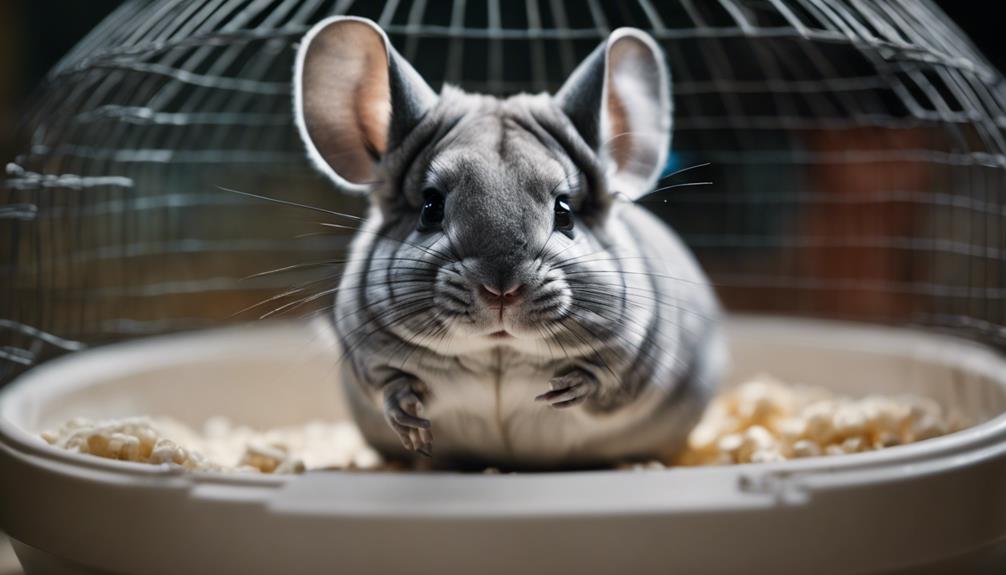
To maintain optimal cage hygiene for chinchillas, ensuring clean and healthy food and water bowl maintenance is essential. Regularly cleaning and disinfecting food and water dishes is crucial to prevent bacterial growth and keep your chinchilla healthy. Use a mild detergent and hot water to wash the bowls, ensuring all food residues are removed. Rinse thoroughly to eliminate any soap residue that could be harmful to your pet.
Food and Water Bowl Maintenance Tips:
| Food Bowl | Water Bottle |
|---|---|
| Wash daily with hot water and mild detergent | Check for leaks regularly |
| Scrub off any stuck-on food particles | Clean nozzle to prevent blockages |
| Rinse thoroughly | Replace water every day |
| Disinfect weekly to prevent bacterial buildup | Check for signs of wear and tear |
For water bottles, ensure they are leak-proof and the nozzle is clean to prevent blockages. Replace the water daily and check for any signs of wear or leaks. By following these maintenance tips, you can ensure your chinchilla has access to clean and fresh food and water, promoting their overall health and well-being.
Monitoring Chinchilla’s Health and Behavior
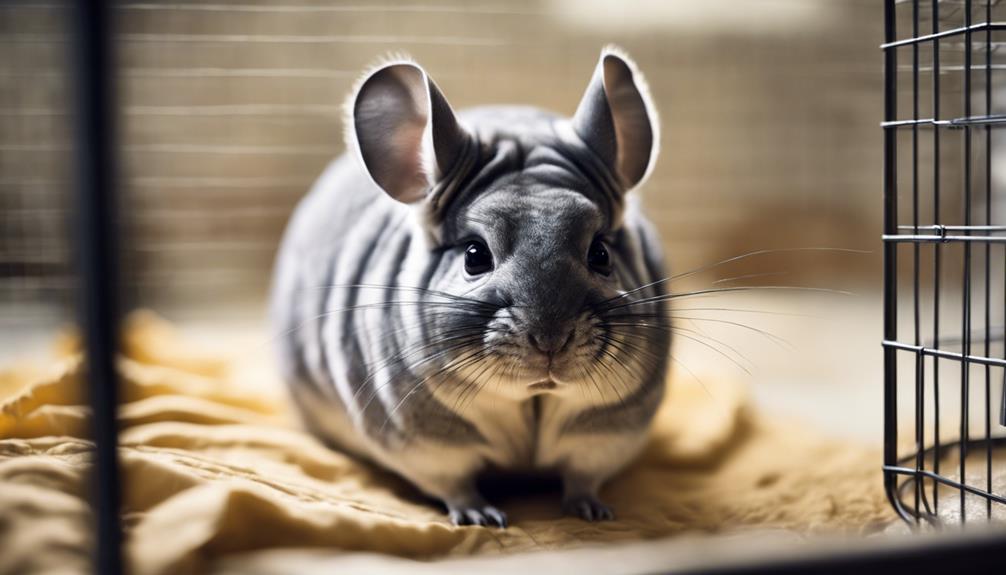
Proper monitoring of a chinchilla’s health and behavior is crucial for early detection of any potential issues. Conducting regular health checks and observing their behavior can provide valuable insights into the well-being of these delicate pets.
Here are some key aspects to focus on when monitoring your chinchilla:
- Health Check
- Regularly inspect their eyes, ears, nose, teeth, and fur for any signs of abnormalities.
- Monitor their weight and appetite to ensure they’re eating well and maintaining a healthy size.
- Keep an eye on their feces for any changes in color, consistency, or frequency.
- Behavior Observation
- Watch for any sudden changes in behavior such as increased aggression, lethargy, or excessive hiding.
- Pay attention to their activity levels and interactions with cage mates to spot any unusual patterns.
Frequently Asked Questions
Can Chinchillas Be Potty Trained to Help Maintain Cage Hygiene?
Chinchillas can be potty trained through consistent training techniques and a rewards system. Providing a designated litter box or hay corner encourages good habits. With patience and positive reinforcement, chinchillas can maintain cage hygiene effectively.
How Often Should Chinchilla Toys and Accessories Be Cleaned?
Chinchilla toys and accessories should be cleaned regularly to maintain hygiene. Toy rotation is key to prevent boredom and ensure cleanliness. Consider the cage layout when placing toys to facilitate cleaning and provide a stimulating environment for chinchillas.
Are There Any Specific Cleaning Products That Should Be Avoided When Cleaning a Chinchilla’s Cage?
Safe disinfectants are crucial for chinchilla cage cleaning. Avoid harsh chemicals like bleach or ammonia. Opt for natural alternatives such as vinegar or specialized pet-safe cleaners. Prioritize chinchilla health by steering clear of harmful products during cage maintenance.
Is It Necessary to Remove the Chinchilla From the Cage During Deep Cleaning?
During deep cleaning, cage supervision is crucial. Chinchilla temperament varies, some may handle it well, others get stressed. Observing their reactions helps. If stress is high, removing them temporarily is advisable to maintain their well-being.
How Can I Prevent Odors From Building up in the Chinchilla’s Cage Between Cleanings?
To control odors in a chinchilla’s cage between cleanings, consider using odor-absorbing bedding like aspen shavings or paper-based options. Properly layout the cage to allow for good ventilation. This helps reduce moisture buildup and keeps the area fresh.











